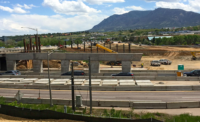A dormant nuclear power plant near Olympia, Wash., may never generate power, but the Laborers' International Union of North America is putting a lot of energy into adapting the site's abandoned 1,500-ft-long tunnel as a training tool.
Located at the former Washington Public Power Supply System site, which was abandoned in 1982 after it defaulted on bond payments, the tunnel now serves the union’s new tunnel safety school. It is the only one in North America that targets construction, the laborers say. Augmenting the instruction is $130,000 worth of tunnel-boring machine (TBM) components donated by local contractors.
“With multiple tunnel projects on the horizon in this region, having a local world-class bored-tunnel program means we can train many laborers and workers in our communities and attract others from around the U.S. and the world,” says Mike Warren, executive director of the Northwest Laborers-Employers Training Trust Fund in Elma, Wash.
Laborers’ union locals in the area already had created a basic tunneling course, but after a fatal accident on an Obayashi Construction Inc. rail tunnel job in 2007, creating new safety training improvements became a major priority, Warren adds. Also funding the training is the Washington Laborers-Employers Cooperation and Education Team, a management-union group linked to the trust.
Several engineering schools, such as the Colorado School of Mines, Golden, teach tunnel safety but related only to mining. “We took the information from the mining programs and tweaked it,” says Warren. Experts from the Laborers’ union, other trades, the Seattle-based University of Washington and government agencies adapted available materials for construction use.
Working in a deep-bore tunnel is different than working on other construction projects “because there are 1,001 moving parts in a tunnel, and you have air quality, electrical hazards and lots of pipes that are under high pressure,” says Warren.
Even so, more Seattle-area transportation and utility owners are looking to deep-bore tunneling as a way to address ongoing problems, such as a lack of available aboveground space and right-of-way issues. “The glacial till and groundwater pressure make tunneling impossible to complete any other way,” says Anita Johnson, a safety consultant for Jacobs Engineering Group. “If they used blasting, the entire tunnel would collapse.” The Pasadena, Calif., firm is a consultant on the $1.85-billion Brightwater sewerage conveyance project, set to finish in 2012, in Kings County. The project includes 13 miles of deep-bored tunnel.
Within the next few years, local transit officials will begin several other tunnel projects as part of a new light-rail system. The state Dept. of Transportation also plans to replace the aging Alaskan Way Viaduct with a one-mile tunnel under downtown Seattle. Officials plan to select the winning construction team in January and begin the project’s tunnel portion next fall.
Vinci, Parsons, Frontier-Kemper, a former joint-venture contractor on the project, donated the TBM components from a finished segment. Donations from the county and other contractors include 100 linear ft of concrete tunnel-wall segments, a decompression chamber and 300 ft of railroad track.
The site tunnel, once used to connect its two nuclear-plant cooling towers, has a rail system and other components that simulate a traditional deep-bore tunnel. The union leases the site from the U.S. government. Above ground, engineers have erected a 50-ton, 17.5-ft-dia cutter head, a 74.5-ton front shield, a 45-ton middle shield, two 5.5-ton man locks and 100 ft of ring steel and wood lagging.
Digging Deep Students will be able to practice replacing the TBM’s cutter-head teeth and other parts but will not operate the equipment or take it apart, school officials say. Officials from the Vinci joint venture and Brightwater’s utility owner still are negotiating legal and financial issues, including those generated when the equipment became stuck during operation.
Modules for the 40-hour training program include segment erection, conveyor systems, excavation, hyperbaric operations, confined-space practices, crane hazards, fire safety, personal protective equipment and communications. “Students will be able to experience the visual aspects of being in a tunnel,” Johnson says. “With the components erected aboveground, it will look like they are inside the machine.”

KIME
The school is open to any Laborers’ union member as well as to engineers and contractors involved in tunneling. Two state labor agency employees attended the first course. Furthermore, other unions, including operating engineers and carpenters that represent those involved in local tunneling work, will be encouraged to send workers. The first students completed the course in early October. “With the University of Washington onboard, we hope to give educational credit,” says Warren.
The Associated General Contractors of Washington became involved when government agencies realized their own inspection employees had no access to tunnel safety training, says Mandi Kime, AGC safety director. “In a poorly lit environment, knowing how to tell where everyone is and knowing how to exit are very important,” she says.
School officials now are negotiating to obtain pieces of another TBM in use on the Brightwater project that also has become stuck. Jay Dee/Coluccio, a joint-venture contractor that replaced the Vinci team last summer, will spend $4 million to freeze the ground around the TBM’s cutter head, then cut apart and remove the machine by next spring.








Post a comment to this article
Report Abusive Comment